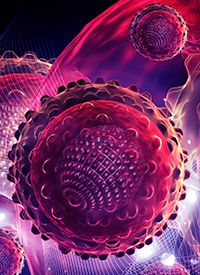Article
NBTXR3 Activity in Soft Tissue Sarcoma Could Be Replicated in Other Cancers
Author(s):
NBTXR3, a novel radioenhancer, is showing intriguing response rates in adult patient with soft tissue sarcoma, paving a path for the innovative therapy not just in sarcomas, but other tumor types, as well.

NBTXR3, a novel radioenhancer, is showing intriguing response rates in adult patient with soft tissue sarcoma, paving a path for the innovative therapy not just in sarcomas, but other tumor types, as well.
In the multicenter, open-label, controlled, randomized, phase 2/3 Act.In.Sarc trial (NCT02379845), investigators enrolled patients with locally advanced soft tissue sarcoma of the extremity or trunk wall who required postoperative radiation. Patients were randomized to receive NBTXR3 at a fixed concentration of 53.3 g/L as a single intratumoral administration prior to preoperative external beam radiation (n = 89) or radiation alone (n = 90), followed by surgery.
Preliminary results showed that a pathologic complete response (pCR) was achieved in 16% of patients on the NBTXR3 group versus 8% on radiation alone (P = .044). Regarding safety, the most common treatment-emergent grade 3/4 adverse events (AEs) related to NBTXR3 was hypotension (7%), and serious AEs were observed in 39% of patients on NBTXR3 and 30% of those on radiotherapy alone. No treatment-related deaths occurred.
In an interview with OncLive, lead study author Sylvie Bonvalot, MD, PhD, of SARCOMA of Institut Curie, dove into the novel molecule of NBTXR3 and the impressive results shown in soft tissue sarcoma and how they could apply to other malignancies.
OncLive: Please describe the mechanism of action for NBTXR3. What is the rationale to build this type of agent and explore it in sarcoma?
Bonvalot: NBTXR3 is a tumor-agnostic, first-in-class radio enhancer made of functionalized crystalline hafnium oxide (HfO2) nanoparticles. These HfO2 nanoparticles are designed to increase the energy deposit from radiotherapy inside tumor cells and to trigger cellular destruction through a physical, universal mode of action.
Normally, x-rays (such as those used in radiotherapy) interact with water molecules in tumor cells and generate electrons and secondary photons. Thus, [it produces] reactive oxygen species (ROS; oxidative stress) and DNA damage, leading to subsequent cell death. The interaction of x-rays with the HfO2 nanoparticles, due to their high electron density, is higher than with water molecules. Therefore, the interaction generates many more electrons and more oxidative stress.1,2
The rationale to use these nanoparticles is to increase the production of oxidative stress and DNA damage within the tumor cells. This leads to increased tumor cell death when compared [with] radiotherapy alone, without adding toxicity to adjacent healthy tissues. Given that the dose and resulting efficacy of radiotherapy is often limited due to radiation-induced toxicity, we hypothesized that this new therapeutic approach might help to improve outcomes for patients.
We decided that soft tissue sarcomas (STS) of the extremity or trunk wall would provide ample opportunity to assess the validity of the HfO2 nanoparticles activated by radiotherapy. First, the product candidate is injected directly into the tumor, only once prior to radiotherapy treatment and tumors of the extremity and trunk wall are easily accessible for intratumoral injection.
Second, locally advanced STS, with tumors that are either newly diagnosed or relapsed, are high-risk tumors that can be borderline unresectable or unfeasible for carcinologic surgical resection. Preoperative radiotherapy is part of the standard of care for these cases, with the main long-term advantage of lower late morbidity (fibrosis, bone fracture, etc.), improved long-term functional outcomes, and improved quality of life. Since the HfO2 nanoparticles must be activated by radiotherapy, it made sense to evaluate safety and efficacy in this indication.
The objective of preoperative treatment for patients with locally advanced STS is to control tumor growth, allowing the achievement surgical resection with no remaining tumor cells (R0 resection margin) while preserving organ integrity and function. Surgical resection with negative margins (R0) is a validated surrogate for local control in limb sarcoma and for overall survival in truncal or girdle sarcoma. pCR to preoperative treatment is also associated with long-term benefit3 but is rarely achieved with preoperative radiotherapy.
The hypothesis for Act.In.Sarc was that by improving the efficacy of radiotherapy without adding toxicity, the HfO2 nanoparticles might improve both pCR rate and R0 resection margin rate. Additionally, pCR was the most objective parameter to evaluate the biological efficacy of the HfO2 nanoparticles, and could provide a more rapid answer about the benefit of this product candidate when compared with survival endpoints.
What is most intriguing about the efficacy and safety data of the Act.In.Sarc study?
Act.in.Sarc is a randomized phase II/III trial evaluating the HfO2 nanoparticles activated by radiotherapy, compared [with] radiotherapy alone, in patients with locally advanced soft tissue sarcomas of the extremity or trunk wall. The study included a total of 180 patients in 32 centers across 11 countries.
The most intriguing efficacy data was the rate of pCR (less than 5% remaining viable tumor cells), which is a direct indicator of the radiotherapy’s effect. This was achieved in twice as many patients in the test arm as in the control arm (16% vs 8%; P = .044).4 Importantly, this evaluation was performed by a group of specialized pathologists who were blinded to the treatment and who followed recently published guidelines.5
The proportion of patients with R0 margin was also higher in the test group (67/87, 77%) than in the group receiving radiotherapy alone (57/89, 66%; P = .042). The proportion of patients with R0 resection margins in the control group was only slightly higher than previously observed in a retrospective study of patients with soft-tissue sarcoma treated at various French centers (57.5%)6, which indicates that the study was well controlled.
Patients showed a good local tolerance of the HfO2 nanoparticles and the product candidate did not increase the severity or incidence of radiotherapy-related adverse effects. Moreover, administration of the HfO2 nanoparticles was generally well tolerated and did not impact the planned radiotherapy schedule.
Could you highlight the clinical implications of the Act.In.Sarc trial findings?
Sarcomas are not the most radiosensitive tumors, and we can thus expect the HfO2 nanoparticles to improve the efficacy of radiotherapy in other tumor types that are more radiosensitive. We can also expect the product candidate to improve the efficacy of radiotherapy in various solid tumors that are often non-resectable, such tumors located in the head and neck, pancreas, or brain. These HfO2 nanoparticles are currently being evaluated in several tumor types, and it will be interesting to see if this hypothesis is proven.
What does patient selection look like for this type of treatment? How will you decide if a patient should receive radiation plus or minus NBTXR3?
Patient selection for the HfO2 nanoparticles activated by radiotherapy focuses on those with marginally resectable tumors, and possibly patients who require reirradiation. The Act.In.Sarc study demonstrated that the product candidate improves the efficacy of radiotherapy without adding toxicity or impacting healthy tissues—resulting in a better quality of surgical margin. The HfO2 nanoparticles activated by radiotherapy could thus be used to treat patients with marginally resectable or, potentially, with non-resectable tumors.
What are the planned next steps for this agent? Could this be tested in other sarcoma subtypes?
These HfO2 nanoparticles are currently being investigated globally in several clinicals trials, both as a single agent active by radiotherapy and in combination with other anti-cancer therapies, including immune checkpoint inhibitors and chemotherapy. A particularly interesting evaluation would be in patients with non-resectable tumors, as the pCR is an important goal that would either help postpone or prevent amputation of limbs.
For patients with head and neck or truncal tumors that are non-resectable, it may also help improve overall survival. Additionally, it would be interesting to evaluate if the HfO2 nanoparticles could be used to reduce the dose of radiotherapy while still allowing treatment to achieve comparable efficacy. This approach would be of great interest, especially in elderly, pediatric, and head and neck cancer populations.
Ultimately, the goal should be to continue expansion of clinical evaluation so that the potential benefits of the HfO2 nanoparticles can be fully explored and, hopefully, improve treatment outcomes for patients in any indication where radiotherapy is a part of the standard of care.
References
- Maggiorella L, Barouch G, Devaux C, et al., Nanoscale radiotherapy with hafnium oxide nanoparticles. Future Oncol. 2012;8(9):1167-1181. doi:10.2217/fon.12.96
- Marill J, Anesary NM, Zhang P, et al. Hafnium oxide nanoparticles: toward an in vitro predictive biological effect? Radiat Onc. 2014;9(1):150. doi:10.1186/1748-717X-9-150
- Salah S, Lewin J, Amir E, et al. Tumor necrosis and clinical outcomes following neoadjuvant therapy in soft tissue sarcoma: a systematic review and meta-analysis. Cancer Treat Rev. 2018;69:1-10. doi:10.1016/j.ctrv.2018.05.007
- Bonvalot S, Rutkowski PL, Thariat J, et al. NBTXR3, a first-in-class radioenhancer hafnium oxide nanoparticle, plus radiotherapy versus radiotherapy alone in patients with locally advanced soft-tissue sarcoma (Act.In.Sarc): a multicentre, phase 2-3, randomised, controlled trial. Lancet Oncol. 2019;20(8):1148-1159. doi:10.1016/S1470-2045(19)30326-2
- Wardelmann, E, Haas RL, Bovée JVMG, et al. Evaluation of response after neoadjuvant treatment in soft tissue sarcomas; the European Organization for Research and Treatment of Cancer-Soft Tissue and Bone Sarcoma Group (EORTC-STBSG) recommendations for pathological examination and reporting. Eur J Cancer. 2016;53:84-95. doi:10.1016/j.ejca.2015.09.021
- Blay, J.Y., et al., Surgery in reference centers improves survival of sarcoma patients: a nationwide study. Ann Oncol, 2019. 30(7): p. 1143-1153.









